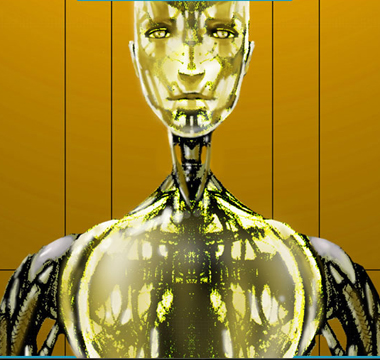
Robots in factories don't resemble R2-D2, the charming electronic handyman in "Star Wars" films. They tend to be faceless machines doing heavy, repetitive chores. Often they are sealed in cages so they don't knock someone's head off when they swing a steel arm.
工厂里的机器人长得并不像影片《星球大战》(Star Wars)里那个好玩的机器人阿图(R2-D2),而是一些没有脸部的机器,从事一些重复性的重型工作。它们往往被封闭在铁笼之内,以免钢臂挥动时磕碰到旁边的工人。
Now, cheaper and more advanced sensor technology promises to let robots work in closer proximity to people, without maiming or bumping into them.
如今,随着传感器技术的进步和成本降低,机器人将能在更贴近人类的区域工作,而不会伤及到人类同事。
Companies including Japan's Kawada Industries Inc. and Fanuc Corp. (6954.TO) and Switzerland-based ABB Ltd. (ABB, ABBN.VX) are developing dexterous robots to perform such delicate tasks as assembling smart phones-something now typically done by nimble-fingered women in China.
日本的川田工业株式会社(Kawada Industries Inc.)、发那科公司(Fanuc Corp.)和总部位于瑞士的ABB公司等企业都在研究动作灵巧的机器人,使其从事一些精细化的工作,如装配智能手机等。目前,这种组装工作一般都依靠中国女工的灵巧双手来完成。
If these experimental robots pan out, they may cut the labor costs of consumer-electronic product companies, reducing the allure of low-wage countries.
如果这些目前还处于试验阶段的机器人能够普及推广,将有可能降低消费类电子企业的用工成本,从而放缓发达国家将生产线移往低成本国家的趋势。
The aim isn't to shoo humans out of factories. It is to give people more efficient tools, says Nicolas de Keijser, ABB's global product manager for small robots."There are things that people do better than robots," such as improvising or quickly adapting to design changes, he says. "That will remain so."
ABB公司的小型机器人全球产品经理尼古拉斯•德凯瑟(Nicolas de Keijser)说,使用机器人的目的并不是要把工人赶出工厂,而是为人类提供更有效率的工具。德凯瑟说,“有些事情由人来做要比机器做得更好”,比如即兴调整或快速适应产品设计变化等,“而且今后也将会这样。”
Today, robots are used mostly in making cars and semiconductors or other goods produced in high volumes and requiring force or precision beyond human levels. They are good in warehouses, too. In March, Amazon.com Inc. (AMZN) announced it is paying $775 million to buy Kiva Systems Inc., a maker of squat, cube-shaped robots that move products around shipping centers.
现在,机器人主要应用于汽车和半导体等产品的制造上。这类产品的产量很高,要求的加工力量或精细程度超出人类的水平。此外,机器人在仓储管理中也很管用。2012年3月,亚马逊公司(Amazon.com Inc.)宣布斥资7.75亿美元收购Kiva Systems Inc.公司,后者专门生产在运输中心用于移动仓储物品的矮胖结实的立方形机器人。
Kawada's new NextAge robot, whose sensor eyes give it a passing resemblance to the movie character Wall-E, is "capable of replacing or collaborating with humans." The robots cost about $90,000 for the basic model.
川田公司新推出的NextAge机器人有一双传感器眼睛,外型与电影《机器人总动员》中的清扫型机器人瓦力(Wall-E)很相似,它能“替代人类从事特定工作,或与人类协作完成一项工作。”这款机器人的基本款售价约为九万美元。
Japanese industrial conglomerate Hitachi Ltd. (6501.TO) introduced a NextAge robot last September to a factory outside of Tokyo that makes computer storage products. There, NextAge puts a cover over each hard-disk drive's fan and tightens screws. This simple task, once handled by a person, shaves off nearly a minute of production per disk drive-a big time saver over the span of thousands of devices-and lets the human workers assemble other types of parts.
2011年9月,日本大型产业集团日立公司(Hitachi Ltd.)在东京郊外一家生产计算机内存的工厂投入使用NextAge机器人,由机器人来给硬盘驱动器的风扇加上盖子并拧紧螺丝。这项工作很简单,以前由人工完成,由机器人接手后,每个硬盘的生产时间减少近一分钟──考虑到硬盘数以千计的产量,这可以节约大量时间──解放出来的人力则用于组装其他零部件。
Another Japanese company, Glory Ltd. (6457.OK), started using NextAge in November 2010 to install a tiny part in its money-sorting equipment for retail stores. The company found that using the robot saves labor costs and brings the defect rate near zero, "which is not possible for human workers," a Glory spokesman said. Glory now has 10 NextAge robots in the factory north of Tokyo.
另一家日本企业光荣公司(Glory Ltd.)于2010年11月开始使用NextAge机器人,用于安装其为零售商店生产的货币处理设备上的一个小部件。该公司发现,使用机器人能节省大量人力成本,并使产品瑕疵率降至接近于零,该公司发言人说,“这是人工制造所无法企及的高度。”现在,光荣公司位于东京北部的工厂配备了10台NextAge机器人。
ABB is also developing a humanoid-like robot that can squeeze into small work spaces and learn new tasks quickly. The "dual-arm concept robot" will be agile enough to assemble consumer-electronic products, among other things, ABB says.
ABB公司也在研发一种人型机器人,它能在狭小的场所工作,并迅速学会新的工作任务。公司表示,这款“双臂概念型机器人”十分灵巧,能够用于组装消费类电子产品,还能从事其他一些工作。
In some cases, Mr. de Keijser says, these robots will be interchangeable with people, who could fill in on assembly work while the robots are being reprogrammed for a new product design, for instance. ABB hopes to introduce new robots and related equipment to assemble small parts within the next 12 to 36 months, he says.
德凯瑟说,在有些情况下,这类机器人将可与工人交替使用。比如说,在对机器人重新编程以适应新的产品设计时,可以由工人先顶一阵子。ABB公司希望在未来一到三年内推出能够装配小型零部件的新款机器人及相关设备。
Fanuc, meanwhile, says its new M-1iA robots are being used to assemble such things as electrical fuses and chainsaws.
发那科公司表示,其新款的M-1iA机器人能用于装配电子熔线和链锯等产品。
In theory, robots already can make just about everything. But they aren't very flexible. If a part isn't exactly where it is supposed to be, the robot can't adapt as a person would. Another problem is that programming them to do assembly work can take months. Because product life cycles are short in consumer electronics, manufacturers can't wait for reprogramming every time a design changes.
从理论上讲,机器人已经几乎可以从事任何工作,只是不太灵活而已。如果某个零部件没有装配好,机器人不会像工人那样去主动调整。另一个问题是,给机器人编程以从事装配工作需要花上好几个月时间。由于消费类电子产品的生命周期很短,制造商不可能一有设计变化,就等机器人重新编程再投入生产。












